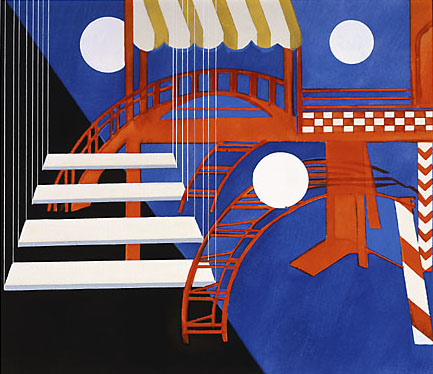КИНЕТИЧЕСКИЕ РИТМЫ
The Dynamic Spirit of Russian Modernism
On view in the Amherst Center for Russian Culture
Located in Webster Hall
Hours & Directions»
Through June 26, 2015
Image


Aleksandra Aleksandrovna Ekster (Russian, 1884–1949). Stage Set Design for Shakespeare's "Merchant of Venice," 1930. Pochoir. Gift of Thomas P. Whitney (Class of 1937), AC 2001.09
In the early twentieth century, artistic movements developed with an unknown intensity and velocity. The Futurist manifesto A Slap in the Face of Public Taste (1912) called to “throw Pushkin, Tolstoi, Dostoevskii etc., etc., overboard from the ship of modernity,” and deemed moderate writers, including Maksim Gor’kii, Aleksandr Blok, and Aleksei Remizov, “insignificant.”
The liberation of the arts from the restraints of the conventional canon was many artists’ major concern. It went hand in hand with artistic innovation. Artists created numerous art “isms”—Neo-primitivism, Cubofuturism, Suprematism, Constructivism, Rayism—in rapid succession, while Futurism was an overarching term used to describe contemporary progressive art.
This exhibition brings together works from the Thomas P. Whitney collection that reflect the dynamic spirit of the artistic milieu of the first three decades of the twentieth century. It exemplifies the many ways of breaking free from the prevalent realistic canon, including Larionov's early aesthetic explorations before 1910, Baranov-Rossiné’s figurative modernism, and Chashnik’s radical geometrical abstraction. Artists from the postwar generation—such as Oleg Kudriashov—frequently referred to avant-garde experiments, particularly geometrical abstraction.
One idea connected many of the artistic experiments despite their visual and conceptual differences: dynamism. While this idea included artistic, social, and technical progress, it took particular visual shape in abstract and nonfigurative artworks. Dynamics referred not only to the depiction of speed and velocity in works of art, but to the presence of a visual tension and a deliberately imbalanced balance, achieved by arranging colors and shapes without introducing a narrative.